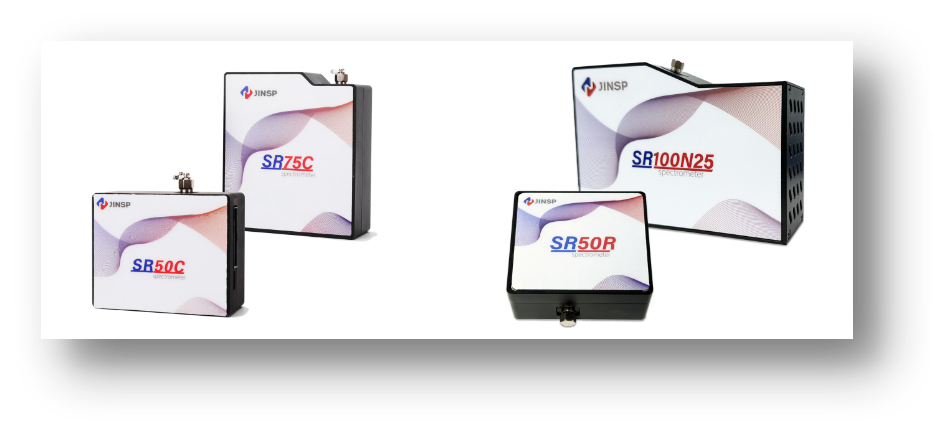With the rapid advancement of artificial intelligence technology, real-time observation and precise data management of Earth's resources are gradually becoming a reality. Ground object spectrometers play a crucial role in obtaining key data. By capturing the spectral characteristics of materials at different wavelengths, these spectrometers greatly enhance our understanding of various natural resources. They enable more reliable and precise assessments of material composition, state, and environmental changes, meeting the demand for in-depth exploration of complex resource environments. Jinsp has achieved significant application results in the field of ground object spectroscopy. The company's compact, easily integrable, high-resolution, and stable spectrometer modules have won wide acclaim and trust from customers.
1. Ground Object Spectroscopy System

A ground object spectrometer is an instrument used to measure the reflected or emitted spectra of objects' surfaces. When sunlight or another light source illuminates ground objects (such as vegetation, soil, water bodies, buildings, etc.), these objects absorb and reflect specific wavelengths of light based on their physical and chemical properties. The working principle of a ground object spectrometer is based on spectroscopy and mainly includes the following steps:
● Light Source Illumination: Natural light or artificial light sources (such as halogen lamps, LEDs, etc.) illuminate ground materials.
● Spectral Collection: Light signals returned from the ground are collected through lenses, cosine correctors, or optical fibers.
● Spectral Detection: The collected light is detected by the spectrometer, capturing the spectral intensity at different wavelengths.
● Signal Processing: The final spectral data is transmitted to a computer or data storage device via communication systems (such as USB or serial ports based on SR50C) for subsequent analysis.
Ground object spectrometers mainly use point measurement methods, scanning targets point by point during measurement. This approach allows for high-precision spectral data acquisition and strong detail capture capabilities, making it very effective for research and applications requiring precise measurements.
2. System Features
Ground object spectrometers have milestone significance in multiple fields such as ground monitoring, resource management, and disaster warning. They can also be combined with drones, satellites, and remote sensing technologies to further enhance performance and application range. Typically, ground object systems have the following notable features:
● Wide Spectral Coverage: Capable of covering a wide spectral range from visible light to near-infrared (e.g., 400~2500nm), meeting the measurement needs of various ground object characteristics.
● High Precision and High Resolution: Achieving high-resolution measurements through fine optical design and high-resolution detectors.
● Fast Measurement: Quick measurement speed, capable of acquiring a large amount of spectral data in a short time, improving field work efficiency.
● Portability and Durability: Compact design, lightweight, easy to carry to field sites, and with good weather resistance and shock resistance, suitable for harsh environments.
3. Application Fields
Innovations in ground object spectrometer technology have significantly improved the precision and scope of ground cover monitoring. Its extensive applications not only enhance the accuracy of environmental monitoring but also provide scientific basis and technical support for agriculture, geological exploration, urban planning, and more. Additionally, spectrometers exhibit "foresight" capabilities in disaster warning by capturing subtle environmental changes to provide early warnings and reduce disaster losses. Here are the main application fields of ground object spectroscopy:
● Environmental Monitoring: Used for water pollution monitoring, air quality monitoring, soil pollution monitoring, vegetation resource monitoring, etc. By measuring the spectral characteristics of ground objects, their pollution levels and types can be determined.
● Agricultural Assessment: Monitoring crop growth conditions, pest identification, soil fertility assessment, and crop yield prediction. Spectral data reflects the physiological state and nutritional status of crops, providing scientific basis for agricultural production.
● Geological Exploration: Measuring the spectral characteristics of rocks and soils to infer their mineral composition and geological structure, providing technical support for mineral resource exploration and development.
● Urban Planning: Used for urban greening monitoring, building material identification, etc. By measuring the spectral characteristics of urban ground objects, the ecological environment and building quality of the city can be assessed.
● Remote Sensing Ground Verification: Serving as a ground verification tool for remote sensing satellite data, improving the accuracy and reliability of remote sensing data.
● Archaeological Research: Measuring the spectral characteristics of ancient sites or artifacts for dating, material analysis, and protection research.
4. Product Recommendation
Jinsp's mini fiber optic spectrometer is the core component for obtaining the spectral characteristic information of ground objects. It reflects the material composition, structure, state, and other features through spectral information. Suitable for covering the wavelength range required for ground spectroscopy from visible to near-infrared 400~2500nm, it is compact, easy to connect, provides SDK, and integrates easily into customer ground spectroscopy equipment. Different wavelength ranges can be customized. For more details, please visit: Fiber Optic Spectrometers - JINSP Company Limited (jinsptech.com)

5. Conclusion
In summary, ground object spectrometers, with their unique spectral dimension information acquisition capabilities, are gradually becoming a key technological tool for promoting precise management of Earth's resources and enhancing environmental monitoring and disaster warning levels. They are opening a new chapter in human exploration of nature and resource management.
Post time: Jul-12-2024

